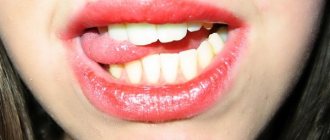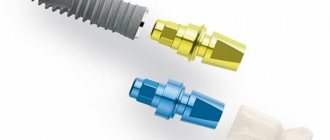Build-up dental restoration – price, features, advantages
Dental restoration – price from 6,000
rubles
Our phone
Build-up is a tooth restoration technology that allows you to perform a complete aesthetic restoration, maintain functionality, and avoid removal. The technique is used provided that the root is not destroyed. It is carried out in stages. It involves strengthening the roots with a metal or fiberglass pin and layer-by-layer restoration of the crown with a composite material.
DentoSpas uses Build-up technology to restore pulpless teeth with severely damaged crowns. We use high-quality materials and strictly follow the treatment protocol, which guarantees excellent results.
It is carried out in several stages.
Endodontic treatment. During it, the pulp, decay products of infected dentin and pulp are removed, and instrumental and medicinal treatment of the root canals is carried out. This allows you to completely eliminate the source of infection, prevent re-infection and tissue inflammation.
Installation of the pin. This is a structure that reinforces, strengthens dentin, strengthens it, and allows you to restore the crown. It is installed inside the root canals and ensures reliable connection of the composite composition with the roots.
Restoration. It is performed layer by layer, with individual selection of the shade of the composite material, complete restoration of the shape and anatomical features of the destroyed crown.
The use of technology allows you to get by with just one visit to the doctor. If the root canals become infected, two visits may be required (elimination of infection during the first visit, restoration at the second visit).
We will call you back within 30 seconds or call +7 (495) 373-10-25
By clicking the “Submit” button, you automatically agree to the processing of your personal data and accept the terms of the User Agreement.
Features of the technology
Not only aesthetic restoration is expected, but also functionality is preserved. If the crown is severely damaged, depulpation is performed. This increases the risk of fracture in the future and requires strengthening of the roots.
Build-up allows you to perform this strengthening most effectively:
- pressure from the coronal part to the root is transmitted evenly, the chewing load is distributed correctly;
- when installing a pin and subsequent restoration, the features of the cavity formed during endodontic treatment are taken into account;
- When filling, compounds are used that give the least shrinkage and fill the formed cavities and root canals as tightly as possible.
When restoring using Build-up technology, active pins are not used, which create excess pressure inside the root canals.
Instead, passive titanium or fiberglass are used, which are fixed inside the channel by cementation. The material, method of fixation, and shape of the rod are selected individually.
In this case, the doctor takes into account the location of its installation, condition, anatomical features of the crown and roots, the plan for further treatment, etc.
The installed structure made of metal or fiberglass performs reinforcing functions, fixes, strengthens, preserves dentin tissue, and serves as the basis for fixing the composite restoration material.
Application
Restoration of crowns damaged by 50% or more.
Strengthening the roots if the dentin in the treated canals is thinner than 2-2.5 mm.
Increased age-related mineralization of dentin (only installation of passive pins using Build-up technology is possible, since active pins, when screwed in, will create an excessive load on the dentin, which can cause it to crack).
Advantages
- Complete restoration in 1-2 visits to the dentist.
- Safe, biocompatible materials are used for treatment. They do not cause allergies, inflammation, or rejection reactions.
- Careful root canal treatment minimizes the risk of re-infection.
- Using a passive pin is a gentle option for root strengthening.
- The coronal part is restored layer by layer with a high-quality composite, matched to the enamel. During restoration, artistic restoration is performed: the shape, size, and anatomical features of the destroyed crown are accurately reproduced. The tooth looks natural and does not stand out in the dentition.
- Long lasting results. The biomechanical properties of the composite used for restoration are no different from dentin tissue. The use of a pin further strengthens it and ensures reliable adhesion between the crown and roots.
The DentoSpas clinic performs dental restoration using Build-up technology using passive titanium and fiberglass pins and high-quality composite materials.
Prices for Build-Up dental restoration:
| Comprehensive oral examination | Diagnostics, development of treatment plan | 900 rubles FREE |
| Consultation with an experienced orthopedic dentist | Doctor of the highest category | 1300 rubles FREE |
| Tooth restoration using Build-up technology | Fiberglass pin, seal included | 8000 rubles |
| Tooth restoration using Build-up technology | Metal pins, seal included | 6000 rubles |
Source: https://dentospas.ru/vosstanovlenie/build-up/
Build-up and play-offs
Build-up
(Build up, literally “building”) and
pay-off
(Pay off, literally “reckoning”) are two fundamental pillars of storytelling. If we compare history with a material body, then the build-up and play-off are like elementary particles that make up both the entire story as a whole and its individual parts.
A build-up is when the author raises the expectations of the audience. Play-offs - when he justifies them. Or he cheats.
At the story level, we call the build-up the “set-up” and the play-off the “climax and resolution.” But the technique itself works not only at the plot level, but also at lower levels, so we cannot always identify the build-up with the plot, and the play-off with the climax and denouement. Build-up and play-offs are possible even at the level of one phrase, or even one phrase. For example, almost all aphorisms have become aphorisms precisely because they have a build-up that arouses the audience’s desire to find out what will happen next, and a play-off that satisfies this desire. For example, the famous “I came, I saw, I conquered” is a vivid example of a build-up and play-off, which, moreover, coincides with the “Rule of Three”. Yes, the Arson, Murder, and Running a Red Light trope is also a good example of a build-up and a play-off.
And it's not just this trope. For example, a trope such as Chekhov’s Gun and all its subtropes is built entirely on the build-up (the “gun” itself) and the play-off (the moment when it “shoots”). Aversion, subversion, inversion of any trope are also based on the fact that first the author makes a build-up of the trope (now I’ll play you this trope, familiar to you, as he promises), and then deceives expectations in the playoffs.
In short, this is the universal of storytelling. It is so universal that there is no need for examples here, because they are literally everywhere.
| [edit] Basics | |
| Basic Concepts | Role • Anachronism • Archetype • Genre • Canon • Codifier/Tropenamer • Conflict • Motif (Biblical • playing cards • bodies) • Gender Expectations • Pathos • First Example • Peripeteia • Character • Derivative Creation • Character Development • Setting • Symbol • Spoiler • Plot/Fabula • Trope/Cliché (endless trope • Cliché storm/Trope on a trope • In-world example • Before it became mainstream • Boomerang trope • Killed cliche vs Fictional cliche vs Unkillable trope) • Fans • Censorship/Decency • Values • Exposition • Focus Episode • Humor/Satire Reality vs. Fiction : The Future Fails to Live Up to Expectations vs. Meta-Prophecy • Life Imitates Art (Unfortunate Coincidence) • History Intrudes into the Plot • Based on a True Story • Disgusting Feedback • Real Life vs. Representation • Reality is unrealistic • That’s how it happened (Cthulhu destroyed the dinosaurs) • Artistic truth |
| Significance of roles | Antagonist (heroic antagonist • no antagonist • antagonist change) • Beta benefit • Deuteragonist • Protagonist (villain protagonist • Loser protagonist • child protagonist • no protagonist • fake protagonist) • Tritagonist • Loads of characters (Who are all these people?) vs Demographic minimalism • A very lonely rooster • Greek chorus Unimportant Important Character • Trinity Syndrome |
| Good and bad | Not a bug, but a feature (Deliberately bad) • So bad that it’s good • Good, but bad • Fatal flaw |
| Directions | Classicism • Sentimentalism • Romanticism (Romanticism vs. Enlightenment Scale) • Realism (Critical • Socialist) • Naturalism • Modernism (Futurism) • Postmodernism • Metamodernism |
| Techniques | Poor man's version • Cheap drama • Pour water • Stiff dialogue • Grow a beard • The paradox of fame/Read a book about yourself • Repeated beginning • Memorial • Sarcasm • The fourth wall (relying on the fourth wall • breaking the fourth wall • The fourth wall will not save you) Allusion : Author winks • Visual reference • Copy-paste • Meta joke • On you! |
| Chronology | Older than dirt • Older than feudalism • Older than print • Older than steam • Older than radio • Older than the Internet |
| Author and another author | Borrowing • Collective creativity • Unintentional coincidence (no, not that one) • Parody (Big alligator effect) • Retelling • Plagiarism/Self-plagiarism • Translator's right (Canonical translator • Established inaccurate translation) • Co-creation • Epigonism (Hitch on the tram) |
| Author and work | Author-creator = creator god : The Will of God • God's Approval • God's Mistake • God Shrug • God's Word • God's False Word (Schrodinger's Lelouch) Author's arbitrariness : And I said - scoundrel! • Author's mayhem • God from the atomic bomb • God from the machine vs Devil from the machine • God the cleaner • Ball game (hero ball • villain ball • idiot ball) • Idiot mystery • Fitting the answer • Piano in the bushes (orchestra in the bushes • black piano) • Convenient loss of information • Author's ears • Soft-boiled chronology • Artistic license • What the hell, author? Author's justification : • Protagonist's immunity vs They're just not heroes • Metaphysical armor • Plot armor (Salvation by canon) |
| Author and audience | Bonuses (bilingual • for adults • for geniuses • for locals • for rewatchers • for contemporaries • for fans (candy for fans)) • Blame it on Doc 2! vs I read a lot of detective stories • Time has not been kind vs Revenged by time • Viewers are geniuses vs The public is a fool • Koreans love StarCraft vs Jews hate Wagner vs We didn’t care about gaijin • Opportunistic revision/Bend under the fans • Royal Giraffe (Effect of inflated expectations) • Critics Can Be Wrong/The Problem of Opposing Assessments (The Dunno Artist Effect) • Hooks for Readers • Don’t read my books! • Haven’t read, but I praise vs Haven’t read, but I condemn • Nobody watches Shakespeare (Homer is a bit predictable) • A million self-references • Cartoons are for children vs Cartoons for adults are South Park vs Cartoons for children are embarrassing vs Anime - these are cruel porn cartoons • The audience is a bastard • Positioning error • The creators went too far • Fanservice (Doctor Fanservice • Miss Fanservice (Mama Fanservice • Beautiful old lady • Berry again) • Mr. Fanservice (Silver Fox) • Professor Fanservice • Seductive nun) vs Fan- disservice • Target audience (Audience miss) • Streisand effect |
| Storytellers | POV Character • Divine Narrator • Chatty Narrator • Dr. Watson • Ishmael • Unreliable Narrator • Posthumous Narrator • Secretive POV Character • Strange Narrator (Animal as Narrator • Sinister Narrator) |
| Kinds of creativity | Folklore • Theater • Complex franchises • Literature • Cinema • Television series • Cartoons • Animated series • Manga • Anime • Comics • Board games • Video games • Visual novel • Music |
| Other | Popular Culture • The grass was greener before |
Tooth inlay: why is it needed and what is it? || Build up in dentistry
“Reconstructive”: they are used for prosthetics of broken, severely worn teeth and in cases where it is necessary to change the inclination of the crown.
Advantages
The only way to fully restore a badly damaged tooth and/or strengthen the remaining root for further prosthetics (artificial crowns or other structures).
Flaws
Significant processing is used only in the reconstruction of “dead” teeth.
Composite
They are used in the same cases as stump ones - but under more favorable conditions (more walls are preserved, less destruction). These are also “tooth inlays”.
Advantages
Production speed: can be produced in one visit. Requires less processing. The cost is lower than that of core and ceramic inlays
Flaws
The greater the destruction, the less strength. Insufficient strength when used in chewing teeth.
All-ceramic
The fundamental difference is that they are placed on “living” teeth, i.e. with preserved nerve. They are used for large chips or as an alternative to conventional fillings for large carious cavities, when it is necessary to change the relief of the chewing surface/to increase the tooth by 1-1.5 mm. These are basically “tooth inlays”.
Advantages
High strength, naturalness, ability to restore chips with relatively little processing, long service life.
Flaws (-)
Requires high precision of work and time for production in a dental laboratory, high cost
Stump
They occur most often. Using their example, you can understand in general terms what dental inlays are, indications and contraindications for them, and general manufacturing principles.
A tooth ground for a crown is called a “stump.” The system implies that the structure is glued (“embedded”) inside the preserved root (as you can see, the name is quite contextual). Such systems resemble a mushroom: the “cap” is the “stump” itself (located above the gum, where the future artificial crown will be), and the “leg” of the tab is fixed in the root canal (see photo).
Stump variant
Used to build up and strengthen “dead” teeth - with a removed nerve, (otherwise - pulpless). Condition: the root should not be soft, rotten, it should not hurt or wobble. The root should not be destroyed under the gum. It is worth noting here that often, due to anatomical features, it is impossible to make inlays for wisdom teeth (“eights”).
Stump systems are the only complete way to restore a destroyed root level with the gum. They strengthen and build up the front (incisors, canines) and lateral, chewing (premolars and molars) teeth of both jaws before prosthetics, when necessary.
The preparation operation and installation are painless, since the work takes place on a “dead tooth.” The patient may only feel a slight vibration or slight heating of the tooth during treatment.
They are used when the crown (the part above the gum - what they actually chew with) is destroyed by half or more. The more left of the tooth, the better for fixing the core system.
Next, such a tooth can be replaced with an artificial metal-ceramic or any other crown, and placed under the support of a bridge.
One of the decisive factors that determines whether the root can be saved is the extent of tooth decay relative to the gum. If the root wall is destroyed by 1 mm or more under the gum, then the tightness of the connection between the “artificial crown inlay” and the root will be compromised. Unfortunately, it is impossible to completely remove or close such destruction.
Stump systems are made from metals (usually cobalt-chromium or nickel-chromium alloys, in case of severe allergies - from gold alloys), zirconium dioxide (valuable for prosthetics of the anterior group of teeth). Metal ones are quite small, weightless, metal detector frames do not react to them, their presence is not a contraindication to MRI.
All-composite
There is a new type of composite material that allows the creation of monolithic, durable, core systems directly in the oral cavity. Special “macro-filled composites” are used, just like conventional fillings, which harden under the light of a dental lamp, but are much stronger and more stable.
They are used in teeth that bear a small load - central, small molars, while preserving most of them. Its relatively recent appearance and insufficient statistics on long-term use make it difficult to reliably assess effectiveness.
Ceramic
One of the types of “metal-free prosthetics”. On a number of points they differ fundamentally from those previously considered. Borderline with such denture structures as veneers.
Ceramic inlays are:
- inlay (installation occurs in the tooth);
- onlay (onlay) is an option in the form of an overlay on the enamel;
- overlay (overlay) design that restores up to a third of the tooth.
Photo of all-ceramic systems on a model
They all look like plates or whole pieces of ceramics (press ceramics), glued to the tooth with special cement (requiring “transmission” with a dental lamp).
They are used to restore chipped living teeth or as a replacement for large conventional fillings. Relevant when restoring damage to the “living” anterior ones located in the smile zone. The tooth must be alive, not hurt, not loose, and be healthy from caries.
This is a good alternative to conventional fillings. Such ceramic systems are a single piece of ceramic with a strong, single crystalline structure. They are stronger than usual and practically do not wear out. Over time, their marginal fit does not change - caries underneath them (“secondary caries”) is practically eliminated. In appearance they are identical to the tooth’s own tissues.
Such fillings have become widespread in Western Europe: due to their strength and aesthetic characteristics, and better biocompatibility with the human body. But such ceramic inlays require careful attention, regular care and cleaning. You should not chew crackers or other hard objects on them.
(about the production of all-ceramic fillings)
Ceramic inlays also include one of the types of adhesive bridges (the so-called Maryland bridges).
They consist of an artificial porcelain tooth, fixed in specially cut grooves on the adjacent ones. Such a bridge structure can replace one small tooth - for example, an anterior tooth or one small molar.
This design is temporary, for beauty (let your missing tooth act incognito).
Maryland bridge
Installation Features
All inlays require grinding of teeth: the difference lies in the volume.
Initially, solid core systems require significant processing: the root canal is processed by approximately half or two-thirds. If the tooth is multi-rooted (two non-parallel canals or more), a collapsible core inlay is made (see video and picture). The dentist then creates a small platform for the core part.
Multi-root collapsible: they are inserted along one or two root canals parallel to each other and are wedged with an additional locking pin - and the pin is inserted at an angle to the main root canals, so the tab is mechanically wedged inside the tooth. After the cement has hardened, the remaining fragment of the locking pin above it is carefully sawed off, and the filling is polished (see video).
(video on dismountable stump systems)
Ceramic requires minimal processing.
In case of restoration of a chip, it is only necessary to slightly grind the sharp edges of the enamel - this will be enough (due to the properties of light-curing cement, there is no need to form complex support platforms for fastening the structure). If you need to install a filling or replace an old one, the treatment is the same as for a regular light-polymer one.
Pain under the tab
Normally, nothing under it should hurt.
The causes of pain may be:
- Overbite. The crown on the stump or ceramic filling is made higher than it should be. Pain when biting, sometimes when touched. They pass quickly without load. The problem is solved by grinding.
- Pain under ceramic fillings: errors in preparing the cavity for the inlay. Grinding or replacement is required.
- Pressure from the edge of the crown on the gum. If you do not make a temporary crown on the stump inlay, the gum may “float” to the edge and when the permanent crown is fixed, such gum may hurt for some time. The pain goes away within a few minutes after cementing the crown.
- Root fracture. Other options should be ruled out first. Always verified by x-ray. The pain is constant and intensifies when you touch the tooth. Often accompanied by swelling of the gums, sometimes bleeding. A root fracture is an indication for root removal











